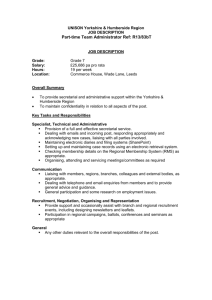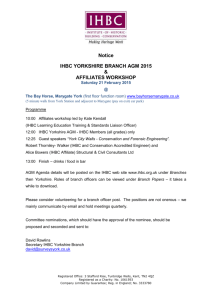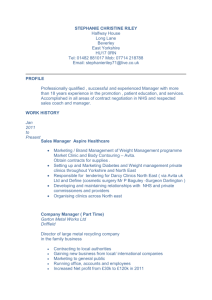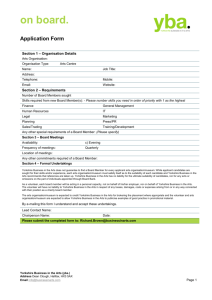A Regional Innovation Strategy: towards a blueprint for Yorkshire
advertisement
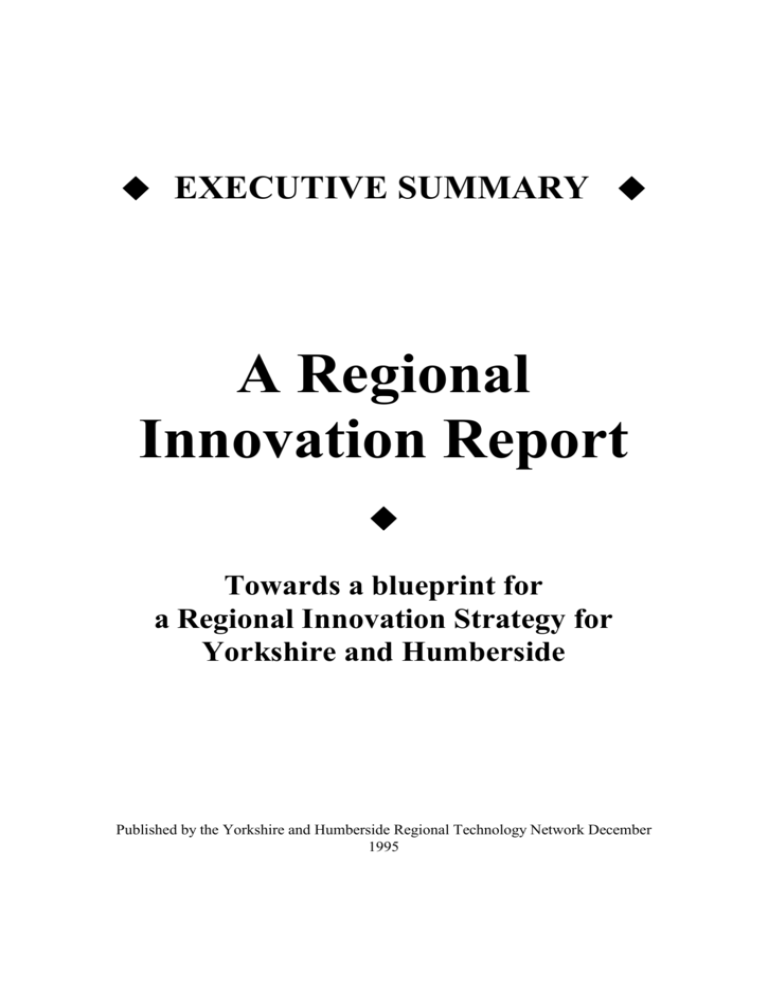
EXECUTIVE SUMMARY A Regional Innovation Report Towards a blueprint for a Regional Innovation Strategy for Yorkshire and Humberside Published by the Yorkshire and Humberside Regional Technology Network December 1995 Towards a blueprint for a Regional Innovation Strategy for Yorkshire and Humberside The world is changing rapidly. Competitive pressures in business and work are being driven by an ever increasing rate of technological development. The incidence of threats and opportunities to our industries and financial welfare are so frequent that the slogan "innovate or liquidate" is becoming a truism. Individually many are doing "their bit" to maintain a competitive edge. Could we do more? Yorkshire & Humberside is not one of the leading technological and innovative regions in the UK or the wider European Community, despite substantial quantities of public money being invested in the region annually to support innovation, research, technology development and management best practice. If we are to maximise the return on this investment, like any good business, we need a Business Plan. This Regional Innovation Report seeks to identify the agenda for the Regional Innovation Strategy, the business plan to take the issue forward.. This executive summary and the associated report detail some of the issues that require addressing to raise our performance to world class. We require a plan which is: Demand Led Defines common goals Defines performance benchmarks Establishes Priorities Builds networks regionally, nationally and internationally Engages the business community in a process of continual review to maintain relevance. Above all, we need a plan that is credible, co-ordinated, clear, correctly resourced, which is led by and reflects the needs of the business community in the region. This report outlines such a plan and also identifies a number of short term activities that can achieve quick results in support of the longer term objectives. 1. Background This study was initiated in response to a perceived need to develop a strategic approach to the co-ordination of structures that support technological innovation and to the allocation of public finance in Yorkshire and Humberside. The objectives were: to audit the existing technological capacity and support infrastructure in the region and assess its suitability as a basis for sustained growth; to evaluate models developed in exemplary innovative regions in other European Union member states; to explore with regional representatives the scope and nature of a future framework for innovation within Yorkshire and Humberside; to provide input to the development of a more extensive regional innovation strategy that would establish a regional consensus and framework for action. The project was carried out in the context of, and with close reference to, two important policy developments. These were: The UK Government’s Technology Foresight programme, which identifies national priorities for technology support: The European Union’s regional policy supported by funding programmes for Regional Innovation and Technology Transfer. The report therefore acts as a first source for further, regionally specific actions in support of these policies. The project was commissioned by the Yorkshire and Humberside Regional Technology Network and funded by the European Regional Development Fund, through the Government Office for Yorkshire and Humberside. The work was carried out by a consortium of regional universities, represented by the Yorkshire and Humberside Regional Research Observatory. 2. The State of the Region A desk study reviewed key economic sources and databases, to identify a baseline analysis of the industrial mix, labour market structure and spatial patterns. This information was related to the technology sectors identified by the Foresight exercise to present a picture of the most significant generic technologies and their position with regard to sectoral drivers. The main results are presented in Table 1. Table 1 Regional Strength and Weakness Strengths Weaknesses Economic and labour force Significant but mature manufacturing base Strong growth of business services sectors Good performance of indigenously owned medium sized companies Well developed urban structure 35% of labour force is manual, of which 60% is unskilled Peripheral to axes of European innovation Poor inward investment performance particularly of R&D facilities limits the inflow of new technology Pluralistic rivalry between urban centres Innovative capacity The nine universities contain major centres of research excellence. They have above average numbers of spin out firms, patent applications and industrial collaborative grant awards. Analysis of the region’s industries indicates good potential in the Foresight sectors of Manufacturing and Business Processes, Food and Drink, Materials. Strong generic technologies in computer aided manufacturing, computer hardware and software, industrial engineering, basic materials and metallurgy, measurement and control, chemical engineering. Isolated and fragmented high technology activity No regional industrial innovation ‘champion’, but a few large and significant players Weak investment by industry in R&D by national standards Key supply chains and technology flows are not regional but national and international Peripheral to axes of European innovation Institutional provision A large number of business support organisations Embryonic networks beginning to emerge Business support organisations are fragmented, poorly co-ordinated and poorly understood by potential users A rapidly changing infrastructure as new institutions come on stream Institutions are not sufficiently aware of or receptive to international experiences 3. Innovative European Regions In order to place the study in a European context, a brief review was made of exemplar regions within the European Union, whose economies are characterised by strong technological development. The key findings were: Regional technology strategies play an important, but not overriding, role in nurturing regional innovation. Successful strategies build on and reinforce co-operation between firms. This builds a constituency that supports longer term agendas. Successful strategies do not seek to cordon off the region, but to build regional networks to transmit information and lessons from the international market. Leading edge firms remain at the technology frontier and encourage other companies to move towards their frontier by implementing good practice. It is not realistic to emulate wholesale the institutional structure supporting innovative regions. Locally specific obstacles to innovation can only be diminished by appropriate locally specific solutions. 4. Preliminary consultations A viable regional innovation strategy must have the support and involvement of the regional stakeholders. As a first step to developing a deeper consensus, ten focus workshops were held. Each workshop involved participants from a particular segment of the region and discussed informally, but in a structured way, the main issues raised by the project. Participation included representatives of recent innovators (big business, small and medium sized business), technology development organisations, business support agencies, university industrial liaison officers, research organisations, social partners and regional partners. Attendees at the workshops raised a wide range of issues, based on their own perceptions and experiences of the region. The key points are summarised. There is a need for immediate action and commitment to develop a long term stability in funding and policy. Resources should be targeted and focused on innovative small firms with growth potential. Traditional enterprises can benefit from lower technology investments. The information highway should be used to support better information flow, but must be based on real demand and with clear objectives. The prevailing image of the region is as a source of cheap labour. The supply of science and engineering graduates needs to be advertised as a key regional asset. Science and engineering awareness and skills acquisition should be promoted from primary schools onwards. The future strategy should address institutional issues and offer leadership in a process of change, network building and partnerships. The success of industrial clusters is often dependent on specific individuals rather than a culture of innovation. 5. A Framework for Action The work done to date is intended as a first step in a long term process to build a regional consensus, to develop and to implement a regional innovation strategy. Two types of action are required - immediate tactical interventions and medium term strategic development processes. 5.1 Immediate interventions to achieve a limited number of early objectives Support selected sectoral innovation foci or networks. These may be developed from existing industrial networks, clubs, technopoles or centres of excellence based on supply chains. Large companies should be involved as exemplars. Explore requirements of large firms with a view to encouraging greater inward investment of R&D activity. Strengthen information flows to develop awareness of best practice and benchmarking. Use existing networks to promote the regional debate on innovation and foresight and to widen access to information about market opportunities. Engage higher and further education institutes more directly as suppliers of technology support. Encourage regional co-operation in virtual research communities. Consolidate training and education initiatives between academia and industry to grow an innovation oriented labour market. 5.2 Medium term strategic development processes The aim must be to narrow the gap between Yorkshire and Humberside and global best practice. This will involve the creation of long term networks between business and regional social partners in support of innovation. The objectives are to develop a wider regional awareness of opportunities and to encourage organisations and individuals to take risks involved in innovative activities. A Regional Innovation Strategy should be built that uses performance indicators to monitor regional innovative performance engages champions to develop and promote elements of the Strategy applies global lessons locally develops smart supply chains and functional networks To be successful, a Regional Innovation Strategy for Yorkshire and Humberside needs credibility, co-ordination, continuity and clarity. It will involve diversification into new technologies; internationalisation, including the attraction of inward investment; modernisation and the application of good practice, and leadership. The Next Stage The long term aim of this project is to develop a realistic and viable strategy to promote innovation and economic growth. This must involve a much wider consultation process and be seen throughout the region as more than mere rhetoric. It must be demand led, articulate common goals, undertake international benchmarking, establish priorities, build networks and links, regionally, nationally and internationally. This requires wider regional consultation, more detailed analysis of regional supply and demand, and the imaginative application of international best practice.

